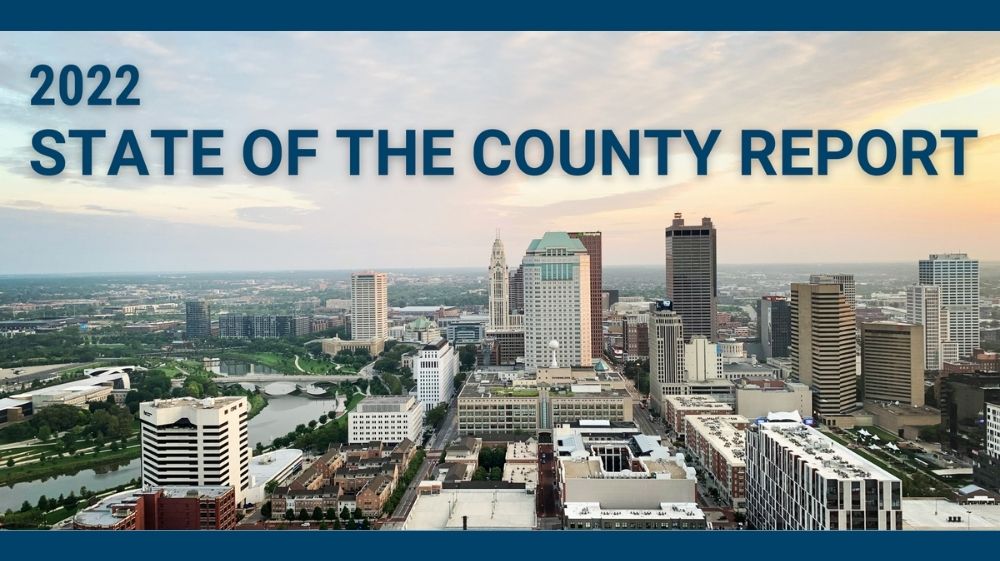A LETTER FROM KEVIN L. BOYCE, FRANKLIN COUNTY COMMISSIONER
Hello and welcome to the Commissioner Connection newsletter.
The new year is off to a great start in Franklin County, though it’s hard to believe that it’s already April.

This is National County Government Month, so we’ve been sharing all month about the ways that our residents’ lives are touched by county government and how we’re working to serve all of our residents throughout the year. In this edition of the newsletter, you’ll learn about several of our big accomplishments from last year and some of what we’ve got in store for the year to come.
One of the biggest happenings from last year was the passage of the American Rescue Plan which provides funding for local governments to use to help their communities recover from the pandemic. When we received the first of our funds from the American Rescue Plan, we held a
public meeting for residents to let us know how they think we can best use that money to help our county recover from the pandemic. We’ve already started getting that money out to the community, and you can learn all about how we’re putting it to good use at our new website,
Recovery.FranklinCountyOhio.gov.
Another way that we’ve been working to help our residents who are struggling with the economic fallout of the pandemic is with rental and mortgage assistance, and you can read about some of that and our new
Rentful614 website later in this newsletter.
An exciting new initiative of the board is a regular video production that we’re calling the
Franklin Five. It’s an opportunity for us to reach out to the residents throughout our county to let them know in real-time about the exciting things going on at the BOC. You can also read later in this newsletter about our partnership with the Harmony Project to protect and make available a historic performing arts center in the Northland neighborhood.
Lastly, I want to direct you to our annual
State of the County report which was just released this month. In it you’ll find pictures, graphs, and videos that tell the story of how your county government is working for you and about the resources that are available to you if you need them.
Thank you again for your interest in all of the exciting things we have going on. I look forward to connecting with you throughout the year, and hope that you will follow us on social media to get all of the latest updates.

Commissioner Kevin L. Boyce
2022 STATE OF THE COUNTY REPORT
 Each year, the Board of Commissioners issues an annual State of the County
Each year, the Board of Commissioners issues an annual State of the County
Report to update residents on the health and progress of Franklin County. In the
2022 edition of the report, the commissionersare pleased to again be able to report thatthe state of the county is strong. To see the full report, visit Report.FranklinCountyOhio.gov.
COMMISSIONERS WORK TO KEEP STRUGGLING RESIDENTS IN THEIR HOMES
 In partnership with the City of Columbus, the Affordable Housing Alliance of Central Ohio, the United Way of Central Ohio, and the Siemer Institute, the Franklin County Board of Commissioners recently launched Rentful614.com – a simple, reliable, and easy-to-access website that links residents to the Central Ohio programs aimed at keeping people in their homes. This website also dispels common myths, provides eviction info customized to Franklin County, and highlights some of the places you can go to get even more help.
In partnership with the City of Columbus, the Affordable Housing Alliance of Central Ohio, the United Way of Central Ohio, and the Siemer Institute, the Franklin County Board of Commissioners recently launched Rentful614.com – a simple, reliable, and easy-to-access website that links residents to the Central Ohio programs aimed at keeping people in their homes. This website also dispels common myths, provides eviction info customized to Franklin County, and highlights some of the places you can go to get even more help.
Early analysis estimated that up to 400,000 Ohio households would be unable to pay their rent because of the pandemic, resulting in lost rent for Ohio landlords as high as $792,000,000. That prediction is matching up with weekly survey results from the U.S. Census Bureau which show that in 2021, on average, 1-in-3 Ohio renters have little or no confidence in their ability to pay next months’ rent. If every one of those at-risk households was evicted, it would represent an almost 700% increase in eviction filings compared to 2016. For comparison, only 330,000 foreclosures were filed during the financial crisis from 2008-2011. A massive surge of evictions and housing loss would impede our economic recovery and push vulnerable families over the edge. Residents seeking information on rental assistance – or landlords looking for help replacing lost rent – should go to Rentful614.com to get the help they need today.
HARMONY PROJECT GETS A NEW COUNTY ADDRESS
 January of this year marked the final step in Franklin County purchasing the Northland Performing Arts Center (NPAC), a ready-to-go facility that will become home to one of our community’s treasures, The Harmony Project.
January of this year marked the final step in Franklin County purchasing the Northland Performing Arts Center (NPAC), a ready-to-go facility that will become home to one of our community’s treasures, The Harmony Project. The Board of Commissioners purchased the property, furniture, fixtures and equipment at Tamarack Boulevard for just over
$2 million dollars, and then approved a 10-year lease with The Harmony Project to operate it.
The Northland Performing Arts Center is part of the last remaining former Northland Mall structure and is physically connected to the building that houses the county’s Northland Opportunity Center and Job Family Services offices. It's also situated next door to the county Dog Shelter & Adoption Center and across the street from the Franklin County Board of Elections, all within a square mile on Morse Road in the Sharon Woods neighborhood.
Over the years, several county agencies have used the NPAC for large meetings and special events and the purchase will continue the county’s access to the center as well as secure its operation as a valuable community asset for generations. Harmony will take over the daily operation and management of the center immediately will begin booking live performances and creating a rehearsal practice hall that will pull hundreds of residents from other parts of the city, providing a direct economic impact to the Northland neighborhood restaurants and businesses. The NPAC will also continue to be available for use by community groups.
Established more than a decade ago The Harmony Project is a local non-profit that works to build a stronger and more inclusive community through the arts and volunteer services. More than 1,000 Harmony Project members sing together weekly, and tens of thousands attend their concerts and performances.
Finding the right location and community to house that many participants has never been easy, and often required multiple rehearsal facilities to accommodate smaller groups that would come together for the first time at performances. NPAC will allow the choir and affiliated programs to flourish and grow in a diverse community for years to come.
With the county’s approval,
Harmony will be making improvements to the current 30,000 square-foot center in order to allow for flexibility in seating and staging set-ups. Versatile facilities, like NPAC are becoming more attractive as performing art centers throughout the country find new ways to support live entertainment throughout a pandemic.
More information on The Harmony Project can be found here.
FRANKLIN COUNTY’S HISTORIC INVESTMENT IN FAMILIES

Last month, the commissioners announced a historic new investment in families and local child care providers that will provide nearly $23 million over two years to support families struggling to pay for child care as well as child care providers and staff.
The program, called
Franklin County RISE, is a partnership with Action for Children and builds on earlier funding from the City of Columbus.
The funding comes from the American Rescue Plan and will help families who are facing the “benefits cliff” in which they make too much to qualify for Publicly Funded Child Care but too little to actually afford the child care they need. It will also support child care centers and their teachers, and will function in three ways: early learning scholarships, incentive payments for child care programs, and financial supports for child care workers.
Nearly one in six of the child care centers in Central Ohio that closed during the COVID-19 pandemic has not reopened, and half of those remaining report that they are not able to cover their expenses.
Families rely on child care to help prepare children for school and so that the parents can work, but high-quality care can cost more than college in Franklin County, and parents who make as little as $25,000 per year don’t qualify for assistance.
Franklin County RISE includes $11.4 million in scholarships for families facing the benefits cliff, and five hundred students are expected to be eligible for up to $10,000 per year in scholarships.
A recent report found that investments in quality child care for disadvantaged children yields a lifetime return of greater than 10:1, an economic impact of more than $110 million for the scholarships.
The support to providers totals more than $11.3 million in four funding areas: as many as 750 providers are expected to receive up to $3,000 per year for taking on low-income families, up to $10,000 for improving their state ratings, and up to $5,000 per year for expanding to non-traditional hours. In addition, $500,000 of the
RISE funding is dedicated to emergency rental assistance for child care workers. These vital teachers are predominantly women and people of color and chronically underpaid, with an average wage for credentialed lead teachers just $12.22 per hour—about 41% of the median income for Franklin County.
RISE teacher supports will offer an average of $3,000 in rental assistance payments per household.
To learn more about the Franklin County RISE program, including detailed eligibility requirements, and to apply for the scholarships or incentives,
visit RISE.FranklinCountyOhio.gov.